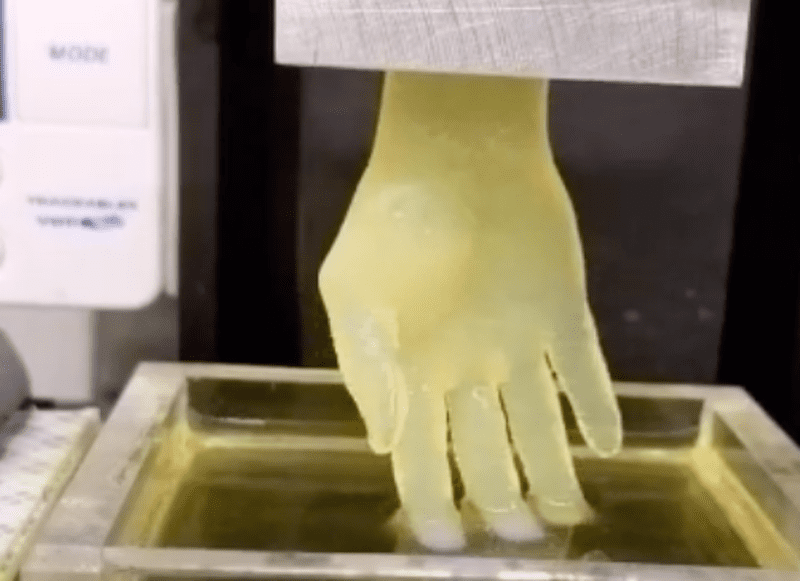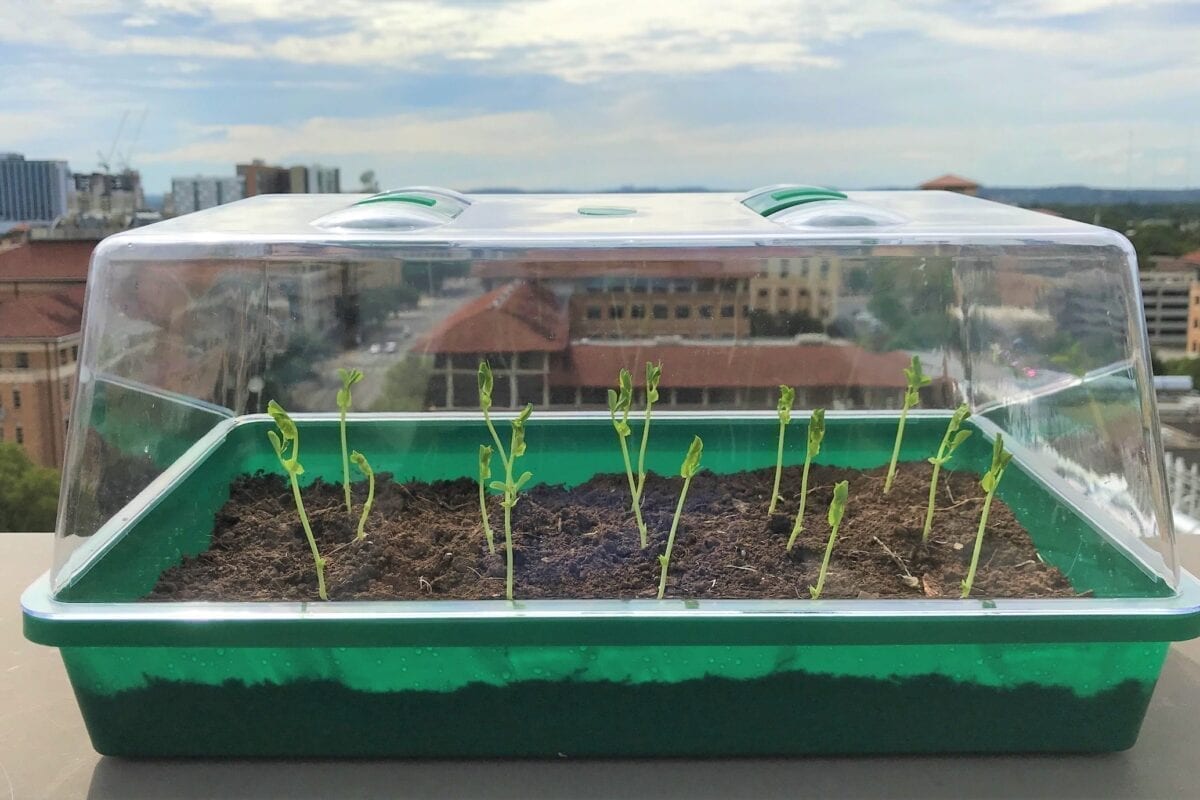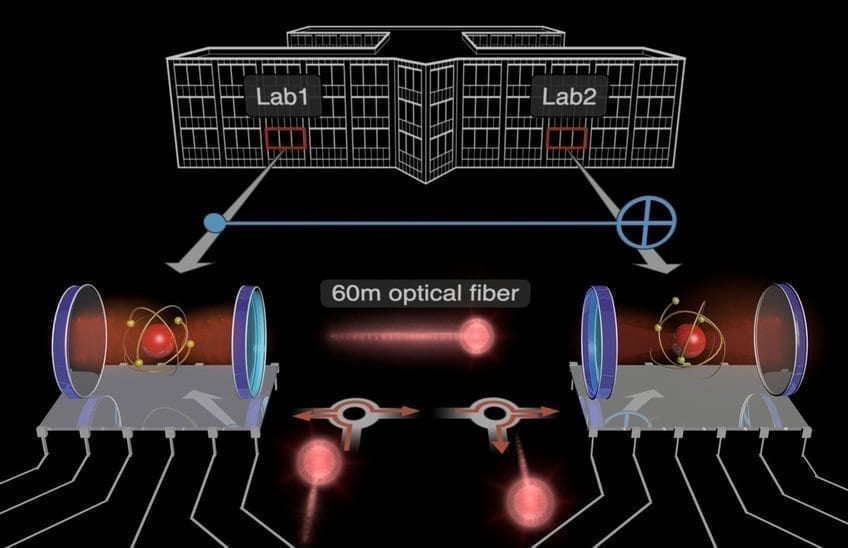
via University at Buffalo
It looks like science fiction: A machine dips into a shallow vat of translucent yellow goo and pulls out what becomes a life-sized hand.
But the seven-second video, which is sped-up from 19 minutes, is real.
The hand, which would take six hours to create using conventional 3D printing methods, demonstrates what University at Buffalo engineers say is progress toward 3D-printed human tissue and organs — biotechnology that could eventually save countless lives lost due to the shortage of donor organs.
“The technology we’ve developed is 10-50 times faster than the industry standard, and it works with large sample sizes that have been very difficult to achieve previously,” says the study’s co-lead author Ruogang Zhao, PhD, associate professor of biomedical engineering.
The work is described in a study published Feb. 15 in the journal Advanced Healthcare Materials.
It centers on a 3D printing method called stereolithography and jelly-like materials known as hydrogels, which are used to create, among things, diapers, contact lenses and scaffolds in tissue engineering.
The latter application is particularly useful in 3D printing, and it’s something the research team spent a major part of its effort optimizing to achieve its incredibly fast and accurate 3D printing technique.
“Our method allows for the rapid printing of centimeter-sized hydrogel models. It signi?cantly reduces part deformation and cellular injuries caused by the prolonged exposure to the environmental stresses you commonly see in conventional 3D printing methods,” says the study’s other co-lead author, Chi Zhou, PhD, associate professor of industrial and systems engineering.
Researchers say the method is particularly suitable for printing cells with embedded blood vessel networks, a nascent technology expected to be a central part of the production of 3D-printed human tissue and organs.
A provisional patent of the technology is being filed, and a startup company has been formed to commercialize the technology.
Original Article: Rapid 3D printing method moves toward 3D-printed organs
More from: University at Buffalo | Syracuse University | Icahn School of Medicine at Mount Sinai
The Latest Updates from Bing News & Google News
Go deeper with Bing News on:
3D-printed human tissue
- 3D Printed Silk Bio-Ink Shows Potential for Knee Meniscus Repair
Researchers have developed a silk-based bio-ink to 3D print a meniscus for better knee repair and regeneration.
- Team replicates an adult human ear using tissue engineering, 3D printing
The sterilized cartilage was placed on ear-shaped plastic scaffolds created on a 3D printer, featuring the dimensions and curves of the person’s ear. The researchers explained that the small pieces of ...
- Tissue engineering and 3D printer replicate adult human ear
A replicated adult human ear that looks and feels natural has been developed by a team using a 3D printer and tissue engineering techniques. Pictured is the left-ear plastic scaffold that was created ...
- Lifelike Replica of Adult Human Ear Using 3D Printing
3D printing combined with tissue engineering creates lifelike ear ... the replicas’ flexibility and elasticity similar to human ear cartilage, although they were not as strong and could tear.
- 3D-Printed Tumors Replicate Biopsies of Cancer Patients
This results in more physiologically relevant, human-based tumor tissues and also provides high quantities of 3D-printed tumors from individual tumor biopsies. Therefore, scientists can perform ...
Go deeper with Google Headlines on:
3D-printed human tissue
[google_news title=”” keyword=”3D-printed human tissue” num_posts=”5″ blurb_length=”0″ show_thumb=”left”]
Go deeper with Bing News on:
3D-printed organs
- Students in UNF's Anatomy in 3D class create detailed models of human organs
UNF teaching assistant Molly Dobrow lifts a miniature 3D printed lungs and heart created by the Anatomy in 3D class from a bath of sodium hydroxide.
- UNF, Mayo Clinic partner on 3D anatomy printing course
The course gives biology and engineering students hands-on experience in an emerging field that will help improve patient outcomes.
- Stanford STEMfest draws a crowd of 3,000 science lovers
At around 30 booths, people stopped by to learn about a range of STEM-related subjects, from cosmic rays, solar telescopes, astrophysical magnetism and automobile engineering to orthopedics, ...
- Latest pig organ transplant in human marks milestone for Maryland company
That work covers xenotransplantation, or the transplant of organs between species; ex vivo lung perfusion, the process of keeping lungs alive outside of the body before they can be greenlit for ...
- Nightlife - Advances in 3D printing and health, economics with Ian Verrender, pickling and preserving 101
FIRST HOUR - ADVANCES IN THE WORLD OF 3D PRINTING - Dramatic advances are taking place in 3D printing human body parts, from new ears to replacement skin and newly made knee cartilage to printed ...
Go deeper with Google Headlines on:
3D-printed organs
[google_news title=”” keyword=”3D-printed organs” num_posts=”5″ blurb_length=”0″ show_thumb=”left”]
[embedyt] https://www.youtube.com/embed?listType=playlist&list=PL0UjJ07OSXC83oV409r1yRju8-ihA1InJ&layout=gallery[/embedyt]










